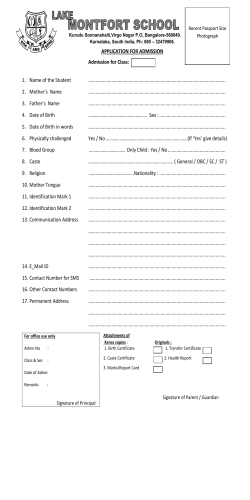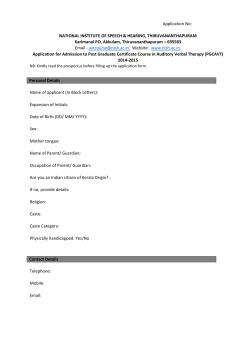
( Political Science ) for class X : Check NCERT SOLUTIONS section.
(www.tiwariacademy.com) (Chapter – 4) (Gender, Religion and Caste) Question 1: Mention different aspects of life in which women are discriminated or disadvantaged in India. Answer 1: In India, women are discriminated and disadvantaged n the following ways: (a) They are not provided adequate education. Thus, the literacy rate among women is just 54%. (b) Most of the labour done by them is unpaid. Where they are paid for their work, they receive lesser wages than men. (c) Due to the preference for the boy child, female foeticide is practiced in many parts of the country. Question 2: State different forms of communal politics with one example each. Answer 2: Different forms of communal politics: (a) The expression of communal superiority in everyday beliefs Militant religious groups are a good example of this. (b) The desire to form a majoritarian dominance or a separate state Separatist leaders and political parties in Jammu and Kashmir and Central India are an example of this. (c) The use of religious symbols and leaders in politics to appeal to the voters This technique is applied by many politicians to influence voters from the two largest religious communities in the country. (d) In addition to all this, communal politics can take the form of communal violence and riots, like the riots in Gujarat in 2002. 1 www.tiwariacademy.com A Free web support in education (www.tiwariacademy.com) (Chapter – 4) (Gender, Religion and Caste) Question 3: State how caste inequalities are still continuing in India. Answer 3: Caste inequalities have not completely disappeared from India. Even today, most people marry within their own caste or tribe. Despite constitutional prohibition, untouchability has not ended completely. Education is not easily available to the so called 'low castes'. Economic status is closely linked to the caste system. In modern India, like in pre-independence India, the poor are mostly the 'low castes' while the rich are the 'high castes', thereby showing that caste inequalities are still continuing in India. Question 4: State two reasons to say that caste alone cannot determine election results in India. Answer 4: Caste alone cannot determine election results in India because: No parliamentary constituency has a clear majority of one single caste. No party wins all the votes of a particular caste. Question 5: What is the status of women’s representation in India’s legislative bodies? Answer 5: When it comes to representation of women in legislative bodies, India is among the bottom group of nations in the world. Women’s representation has always been less than 10% in Lok Sabha and 5% in the State Assemblies. On the other hand, the situation is different in the case of local government bodies. As one-third of seats in local government bodies (panchayats and municipalities) is reserved for women, there are more than 10 lakh elected women representatives in rural and urban local bodies. 2 www.tiwariacademy.com A Free web support in education (www.tiwariacademy.com) (Chapter – 4) (Gender, Religion and Caste) Question 6: Mention any two constitutional provisions that make India a secular state. Answer 6: Two constitutional provisions that make India a secular state are: The Constitution provides to all individuals and communities freedom to profess, practice and propagate any religion, or not to follow any. The Constitution prohibits discrimination on grounds of religion. Question 7: When we speak of gender divisions, we usually refer to: (a) Biological difference between men and women (b) Unequal roles assigned by the society to men and women (c) Unequal child sex ratio (d) Absence of voting rights for women in democracies Answer 7: (b) Unequal roles assigned by the society to men and women Question 8: In India seats are reserved for women in (a) Lok Sabha (b) State Legislative Assemblies (c) Cabinets (d) Panchayati Raj bodies Answer 8: (d) Panchayati Raj bodies 3 www.tiwariacademy.com A Free web support in education (www.tiwariacademy.com) (Chapter – 4) (Gender, Religion and Caste) Question 9: Consider the following statements on the meaning of communal politics. Communal politics is based on the belief that: Α. One religion is superior to that of others. Β. People belonging to different religions can live together happily as equal citizens. C. Followers of a particular religion constitute one community. D. State power cannot be used to establish the domination of one religious group over others. Which of the statements is/are correct? (a) A, B, C and D (b) A, B and D (c) A and C (d) B and D Answer 9: (c) A and C Question 10: Which among the following statements about India’s Constitution is wrong? It (a) prohibits discrimination on grounds of religion (b) gives official status to one religion (c) provides to all individuals freedom to profess any religion (d) ensures equality of citizens within religious communities Answer 10: (b) gives official status to one religion Question 11: Social divisions based on ______________ are peculiar to India. Answer 11: Social divisions based on caste are peculiar to India. 4 www.tiwariacademy.com A Free web support in education (www.tiwariacademy.com) (Chapter – 4) (Gender, Religion and Caste) Question 12: Match List I with List II and select the correct answer using the codes given below the Lists: List I 1. 2. 3. 4. List II A person who believes in equal rights and opportunities for women and men A person who says that religion is the principal basis of community A person who thinks that caste is the principal basis of community A person who does not discriminate others on the basis of religious beliefs 1 2 Α. Communalist Β. Feminist C. Secularist D. Castiest 3 4 (a) B C A D (b) B A D C (c) D C A B (d) C A B D Answer 12: (b) 1 2 3 4 B A D C 5 www.tiwariacademy.com A Free web support in education
© Copyright 2025

















